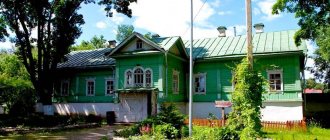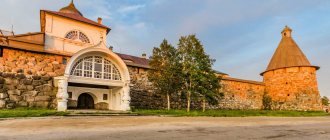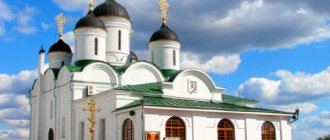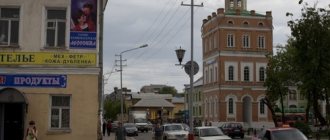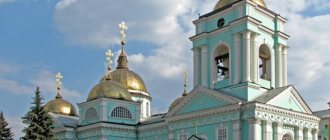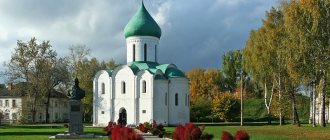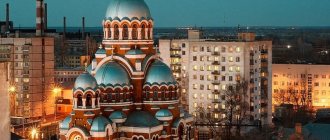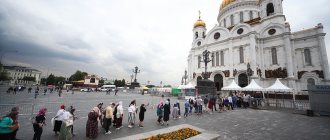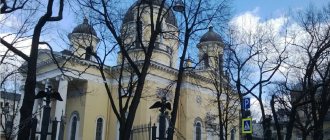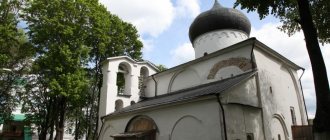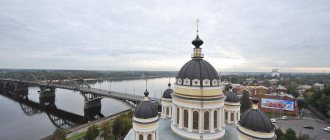The Spaso-Preobrazhensky Monastery is one of the most ancient monasteries; its history began in the second half of the 12th century. Unfortunately, the buildings of that time have not survived, but the architectural ensemble that has reached us with buildings from the 16th–19th centuries amazes with its beauty, grandeur and is worth a visit.
Currently, the Spaso-Preobrazhensky Monastery is part of the Yaroslavl Museum-Reserve. Its exhibitions will tell you about the nature and history of Yaroslavl, and here you will also see a unique collection of icons and treasures.
If you are lucky with the weather, be sure to climb the belfry, which offers a magnificent panorama of Yaroslavl, the Kotorosl River and the outskirts of the city.
In addition to the architectural sights of Yaroslavl, the monastery has monuments built in our time - the chapel of the Kazan Icon of the Mother of God, the Kopeyka monument of 1602 and the monument in honor of Dmitry Pozharsky. Here you will see the living symbol of Yaroslavl - the bear Masha.
History of the Spaso-Preobrazhensky Monastery from the 12th to the 17th centuries
The exact date of foundation of the monastery is not known. But it is believed that this happened at the end of the 12th century.
The monastery walls became part of a well-planned defensive line around Yaroslavl, protecting its western borders. This was hardly the most fortified part of the city, since the Yaroslavl Kremlin was never surrounded by its own stone walls.
The new monastery grew and developed rapidly. At the very beginning of the 13th century, a theological school was opened there, where Orthodox clergy were trained - the Grigorievsky Narthex. It was the first religious educational institution in Northwestern Rus'. After a while, he was transferred closer to the metropolitan - to Rostov.
From left to right: Church of Yaroslavl Wonderworkers, belfry
Almost immediately, the monastery began to collect a library and began copying books. In honor of an important event - the creation of the Yaroslavl principality, the Transfiguration Cathedral was built in stone in the monastery during the reign of Vasily III.
The monastery enjoyed the favor of not only Yaroslavl, but also Moscow princes. Ivan the Terrible loved to be here.
Each time, coming to Yaroslavl, the tsar left letters of grant to the monastery. The monastic properties expanded and wealth grew. The monastery turned into a major feudal lord and owned 6 villages and 239 hamlets. She owned fishing grounds and profitable salt pans. In addition, the monastery was exempt from monetary and economic duties accepted in Yaroslavl, had judicial immunity, and representatives of the ruling elite of the Yaroslavl lands had long been buried on its territory.
From left to right: Belfry, Church of the Yaroslavl Wonderworkers, Spaso-Preobrazhensky Cathedral
He received such privileges from the sovereign because here the wife of Ivan the Terrible was cured of a serious illness. Fyodor, the son of John IV, also provided constant support to the monastery.
When the Time of Troubles, difficult for Russia, came, Yaroslavl was devastated by Polish-Lithuanian troops. Only the Transfiguration Monastery, which withstood a month-long siege, managed not to submit. And the enemy troops had to leave with nothing. It is noteworthy that it was from the walls of this monastery that the second zemstvo militia, led by K. Minin and D. Pozharsky, headed to Moscow, which saved Russia from the invasion. And in the spring of 1613, Mikhail Romanov visited the monastery and signed a letter here indicating his consent to the throne. Later, the first sovereign of the Romanov dynasty also sent rich gifts to the monastery.
After the Time of Troubles, the monastery was significantly strengthened. The perimeter of its powerful three-meter walls exceeded 800 m, and their height reached ten and a half. For defense, arquebuses, carbines and barrels of gunpowder were placed on the stone walls and towers. In Yaroslavl, along the road leading to Uglich, several settlements belonging to the monastery grew up. The economic and political influence of the monastery in those days was not inferior to Yaroslavl Posad.
Holy Gate with the Church of the Entry of the Blessed Virgin Mary into the Temple
Story
The monastery was built at the end of the 12th century on the outskirts of Yaroslavl, at the crossing of the Kotorosl River and served to protect the city from enemy invasions from the west. At that time, all monastery buildings were wooden. The first stone building was the Cathedral of the Transfiguration, built at the beginning of the 13th century, during the reign of the Rostov prince Constantine (before the separation of the Yaroslavl principality).
The first theological school, the so-called Grigorievsky Seclusion, was opened on the territory of the monastery, in the library of which Count Alexei Musin-Pushkin discovered the manuscript of the poem “The Tale of Igor’s Campaign” (this is the generally accepted version and explanation of the collector himself). At the same time, recent research has shown that the manuscript belonged to the library of the Kirillo-Belozersky Monastery, and a successful collector of antiquities most likely appropriated it.
In 1501, there was a fire in Yaroslavl that destroyed most of the buildings, and the Transfiguration Cathedral also collapsed. Four years later, construction of a new temple begins, and the old foundation was used for its construction.
Princes and then kings always revered the monastery. Ivan the Terrible especially loved to be here. In addition to money, the rulers provided the Spaso-Preobrazhensky Monastery with various benefits, for example, they exempted it from a number of duties, donated huge lands, villages, hamlets and fisheries. The period of the 16th–17th centuries was the heyday of the monastery.
In 1608, Yaroslavl was besieged by the Polish-Lithuanian army and only thanks to the steadfastness of the monastery the city was not conquered. It was at the walls of the monastery in 1612 that the militia of Kuzma Minin and Prince Dmitry Pozharsky gathered, from here the Russian army set out on a campaign for the liberation of Moscow from the Polish occupiers.
Due to church reform in 1778, the monastery was abolished. In Soviet times, the ensemble of the Transfiguration Monastery became part of the Yaroslavl Museum-Reserve.
History of the Spaso-Preobrazhensky Monastery in the 18th-20th centuries
In the middle of the 18th century, by decision of the Rostov Metropolitan Arseny (Matseevich), classes in the theological Slavic-Latin seminary began in the monastery - one of the first Russian seminaries. Three decades later, about three hundred students studied there. This seminary was housed in the monastery until 1875.
In 1787, according to the decision of the Russian Empress Catherine II, the Rostov metropolitan see moved to Yaroslavl, and the monastery was converted into a bishop's house. A few years later, in the 90s of the 18th century, among a large library where a lot of ancient books and manuscripts were kept, A. I. Musin-Pushkin made an outstanding discovery in the history of Russian literature. In the Trepezny Chamber of the monastery, among ancient manuscripts, he discovered a unique manuscript “The Tale of Igor’s Campaign,” dated to the 12th century.
This historical find and especially the publication of the text “The Words...” brought the Russian historiographer and collector fame throughout the world.
In the 19th century, several new stone buildings appeared on the territory of the former monastery - a building for seminarians, the Smolensk chapel and a temple dedicated to the Yaroslavl Wonderworkers. In addition, at this time the restoration of the Holy Gate and monastery walls took place.
Church of the Resurrection of Christ (cross)
During the years of Soviet power, various institutions and departments were located in the monastery buildings - a military registration and enlistment office, a prison, a kerosene shop and educational institutions. In the 20th century, this architectural complex was restored twice. In 1918, the walls and churches were damaged as a result of the White Guard uprising in Yaroslavl. The consequences of the destruction were eliminated within five years - until 1923. The second restoration took place in the monastery in 1957-1958. After it, the territory of the former monastery was given to the city historical, architectural and art museum-reserve, which is located here to this day.
The most valuable (unique) collections
- Collection of cash treasures - 54 coins, 3 clothing treasures, 4 treasures of paper banknotes
- Collection of Russian artistic silver from Yaroslavl and Moscow XIII - early. XX centuries Most of the 2 thousand works are objects of Orthodox rite - crosses, icon frames, crowns, tsats, arks, censers, etc. The products of Yaroslavl silversmiths are not only unique historical monuments, but also highly artistic works, distinguished by their bright, unique style and high performance technique
- Collection of rare books (handwritten, parchment and early printed books from the 12th to the 20th centuries) - 12,000 items, many of national and world level
- Collection of silk artistic fabrics. East, Western Europe, Russia (XVI-XX centuries) - about 800 items
- Collection of Yaroslavl provincial portrait - 130 items
- Memorial collection of N.V. Kuznetsov (1902-1958) - more than 800 items
- Collection of icon paintings of the 16th-19th centuries. The collection includes unique complexes of iconostases of Yaroslavl churches
- A collection of facial and ornamental embroidery from the 15th to 19th centuries, including works from the famous Stroganov workshops and local monasteries. About 300 units
Architectural monuments on the territory of the Spaso-Preobrazhensky Monastery
The main architectural monument of the monastery is rightfully considered the Transfiguration Cathedral.
The very first cathedral made of stone was erected in the men's monastery back in 1216-1224. With this construction, the residents of Yaroslavl celebrated the formation of their principality. However, at the very beginning of the 16th century there was a big fire, the temple was badly damaged, and it had to be rebuilt. A beautiful temple, similar to the main Kremlin cathedrals in Moscow, was consecrated in 1516. It is believed that this building laid the foundations for the traditions of the Yaroslavl architectural school.
Chapel of Tryphon
Half a century later, the cathedral was painted with frescoes. Fortunately, they have been partially preserved and today are the oldest frescoes in Yaroslavl. Wall paintings from the time of Ivan the Terrible have been preserved in only two churches in Russia. In addition to Yaroslavl, similar frescoes can be seen in the Bogoroditsko-Uspensky Monastery, which is located in the city of Sviyazhsk in Tatarstan. In the Transfiguration Cathedral, 16 icons painted for the temple iconostasis by Moscow and Yaroslavl iconographers were also miraculously preserved.
The architectural appearance of the cathedral has changed greatly over several centuries. Only the eastern (altar) part of the facade with characteristic semicircular apses has its original appearance. The three-domed temple is crowned with low helmet-shaped domes.
In the 60s of the 16th century, the first tower made of stone was erected on the monastery wall - the beautiful Holy Gate. At the same time, the wooden walls were replaced with stone ones and the Refectory Chamber and the Church of the Nativity of Christ (or the Church of the Cross) were built. Later, at the beginning of the 19th century, this temple was reconsecrated into the Resurrection Church.
Epiphany Tower
Over the years, when the monastery was rebuilt and restored after the Polish-Lithuanian intervention, several stone towers were erected, from which we can still see the Uglich and Bogoroditskaya towers today. The other two towers, Mikhailovskaya and Epiphany, were built in the monastery at the very beginning of the 19th century.
At the end of the 17th century, a cell building was erected in the monastery. Now this two-story building houses museum collections in which you can see precious royal deposits and treasures from Orthodox churches in the Yaroslavl region.
Side by side with the Transfiguration Cathedral stands the Yaroslavl Wonderworkers Church, built in the 30s of the 19th century. It is recognizable from afar by its portico with white columns. This church was laid on the foundation of an older temple - the Church of the Entrance to Jerusalem, which existed here since the beginning of the 17th century.
The belfry is the tallest building on the monastery territory. This bell tower was built in the 16th century. and additionally built in the 19th century. From its high observation deck there are wonderful views of the Korotosli estuary, the Volga and the city itself.
Mikhailovskaya Tower
Several years ago, a memorial stele “Oath of Prince Pozharsky”, decorative beehives for bees, made in the form of architectural monuments - a temple, a tower and a wooden hut, as well as a monument to the “Kopeyka of 1612” were installed on the territory of the monastery.
Construction and establishment
The modern cathedral is the result of centuries of construction. The first - Konstantinov - cathedral stood until the fire of 1501. Although it was made of stone, in the “big fire” the masonry was damaged and the structure became unreliable. The cathedral was dismantled, and Moscow craftsmen, who were specially sent by Vasily III, were invited to build a new one in its place. That’s why we see today in the oldest Yaroslavl church the outlines are somewhat Moscow, evoking the heads of the Kremlin churches of the capital.
However, talented craftsmen did not contradict the emerging unique tradition of building Yaroslavl churches. On both sides of the cathedral, built in 1506 - 1516, it is as if surrounded by a gallery with arched openings; in the past there was also an elegant front porch, which has not been preserved. The gallery served as a repository for books and took the place of the former “open walkway”.
In terms of internal architecture, the Spassky Cathedral is a four-pillar temple on a high basement. It is crowned with three helmet-shaped heads on massive (in Moscow) drums, surrounded (in Yaroslavl) by kokoshniks and resting on uncovered zakomaras.
The skill of Moscow architects is evidenced by the amazing proportionality and harmony of all parts of the temple at that time. From the east, with narrow loophole windows and blank walls, it is simple, strict and majestic, like a warrior monk. The western facade, with a stepped arrangement of volumes and the opening of the triceps in perspective, is complex, picturesque, humane and speaks of the secular service of the monastery, where they pray for each of us.
In 1563–1564, the cathedral was painted by Muscovites Larion Leontyev, Tretyak, Fyodor Nikitin and Yaroslavl residents Dementy and Afanasy Isidorov. The frescoes painted by them are the oldest in Yaroslavl. Their value, however, does not lie in their antiquity alone: only two Russian monasteries - the Assumption (Sviyazhsk) and Spaso-Preobrazhensky (Yaroslavl) - have preserved wall paintings from the 16th century in their entirety.
At the same time, the first tower of stone was erected for the cathedral - the Holy Gate - and a large iconostasis was created, from which 13 icons of the Deesis order (icons depicting the Church’s prayer for peace in the broad sense of the word), a temple image and 3 icons of the local row have been preserved to this day ( locally revered saints).
In the 16th century, the Nativity Church, the Refectory Chamber, and the belfry were built. By the end of the 60s of the 16th century, Ivan the Terrible granted the monastery 55 charters, according to which 239 villages and 6 settlements, salt pans and fishing grounds passed into the ownership of the community. Moreover: Grozny granted the monastery exemption from taxes at the settlement and immunity in court.
The son of Ivan the Terrible, Fedor, continued the tradition of giving. He granted the community 12 certificates of financial support.
Current state and mode of visiting the Spaso-Preobrazhensky Monastery
Today, within the walls of the ancient monastery are the main collections of the Yaroslavl Museum-Reserve.
In this cultural center of the city, Yaroslavl icons painted from the 16th to the 19th centuries are exhibited, as well as unique artistic items made of precious metals. The museum also has exhibitions telling about the nature of the Yaroslavl region, “The Tale of Igor’s Campaign” and the history of the monastery. And for groups of adult visitors and high school students there are several interactive programs and master classes on the etching press. Entrance to the territory and visiting museum exhibitions is paid.
Uglich Tower, view from the monastery territory
From October to April, the area is open to visitors daily from 9.00 to 18.00 (the ticket office closes half an hour earlier). Museum exhibitions are open from 10.00 to 17.30 (the ticket office closes an hour earlier). From May to September the area is open daily from 8.00 to 20.00 (ticket offices close an hour earlier). Museum exhibitions are open from 10.00 to 17.45 (the ticket office is open until 17.00). Day off is Monday.
You can get to the Transfiguration Cathedral in the warm season - from May to September from 10.00 to 18.00. It is closed on Wednesdays and, on the recommendation of restorers, on rainy days.
Activities of the parish
The monastery is inactive today. Here tourists can be told about the history of Russian churches and demonstrated examples of wood carving and ancient Russian art.
The copy of “The Tale of Igor’s Host”, which was made by the monks back in the 13th century, deserves special attention. Frescoes from the era of Ivan the Terrible have also been preserved. Thematic exhibitions are periodically held at the museum.
Shrines
Before its abolition, the shrines of the monastery were the relics of the holy Yaroslavl Wonderworkers, the Spassky Gospel, the Yaroslavl Oranta and Pechersk icons of the Blessed Virgin Mary.
How to get to the Spaso-Preobrazhensky Monastery
The monastery is located at the address: Bogoyavlenskaya Square, 25, in the Kirovsky district of the city, next to the Moscow Bridge over the Korotosl, not far from its mouth.
By car. From Moscow, the M8 federal highway leads to Yaroslavl. Within the city limits it is called Moskovsky Prospekt. The territory of the monastery is located on the right, immediately behind the road bridge over the Korotosl River.
Transfiguration Cathedral
By train. Train express trains travel from Moscow to Yaroslavl in 3 hours and 16 minutes. The journey by regular train takes from 4 to 5.5 hours. From Moskovsky Station in Yaroslavl, the distance to the Spaso-Preobrazhensky Monastery is 2.5 km. You can walk them or take a minibus.
Attraction rating
Rating 5.00 [4 vote(s)]
Embankment and Church of the Epiphany
And it was morning, and it was hot, and the city called and beckoned with unexplored streets, river expanses and ancient churches. And this feeling inside is the anticipation of discovery, slightly tickling the nose and stretching the lips in a smile.
I go out onto Kotoroslnaya embankment, and ahead I can already see the Kremlin tower and the American Bridge , considered the oldest bridge in Yaroslavl. The structure that gave it the name “American” and is a covered iron frame has long since been rebuilt, but the name has stuck.
Before the bridge I turn to the Church of the Epiphany - one of the ancient and outstanding shrines of the Yaroslavl land. The year of foundation is considered to be 1684. Before it, there was a wooden temple of the 16th century.
The church is distinguished by a special painting showing the history of the earthly ministry of Jesus Christ and an architectural design that is unusual for Yaroslavl. However, you can see everything yourself. Entrance to the temple is free.
For me, such places, steeped in centuries-old history, are attractive. Entering inside, it is as if you are immersed in another space/time, and this is felt by the whole being. I want to stay longer, prolonging that feeling of the contact of centuries.
I will note one more interesting detail - on the back side of the temple (view from the Kremlin), a face appeared on the wall through the paint. What and who is a mystery to me:
Face above the reddish spot
And this is a view of the temple from above, from the bell tower located in the Kremlin, where I go.
Epiphany Square and in the center - Yaroslav the Wise . And here, you can’t help but take a thousand rubles out of your wallet and compare.
Yaroslav the Wise is the founder of the city; a monument to him was erected in 1993. The sculpture faces those entering from Moscow, symbolizing close ties with the capital.
An otter was found on one of the fences of the square and information was given that these animals were not uncommon here. The sign says that the otter has 10 lives, and if you pet it, it will share its life energy. The hare Pipus, of course, met this inhabitant of the Yaroslavl land.
The entrance to the Kremlin is also located here, there are several of them. However, first let’s define the terminology: is it the Kremlin? People call this place the Kremlin, although in fact it is the Spaso-Preobrazhensky Monastery, or a historical and architectural reserve . A Kremlin once existed in Yaroslavl on the site of the city's founding, at the confluence of the Volga and Kotorosl, but it was made of wood and burned down long ago.
For ease of explanation, I will continue to call this reserve behind the stone walls the Kremlin.
